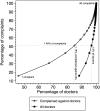Identification of doctors at risk of recurrent complaints: a national study of healthcare complaints in Australia
- PMID: 23576774
- PMCID: PMC3711360
- DOI: 10.1136/bmjqs-2012-001691
Identification of doctors at risk of recurrent complaints: a national study of healthcare complaints in Australia
Abstract
Objectives: (1) To determine the distribution of formal patient complaints across Australia's medical workforce and (2) to identify characteristics of doctors at high risk of incurring recurrent complaints.
Methods: We assembled a national sample of all 18 907 formal patient complaints filed against doctors with health service ombudsmen ('Commissions') in Australia over an 11-year period. We analysed the distribution of complaints among practicing doctors. We then used recurrent-event survival analysis to identify characteristics of doctors at high risk of recurrent complaints, and to estimate each individual doctor's risk of incurring future complaints.
Results: The distribution of complaints among doctors was highly skewed: 3% of Australia's medical workforce accounted for 49% of complaints and 1% accounted for a quarter of complaints. Short-term risks of recurrence varied significantly among doctors: there was a strong dose-response relationship with number of previous complaints and significant differences by doctor specialty and sex. At the practitioner level, risks varied widely, from doctors with <10% risk of further complaints within 2 years to doctors with >80% risk.
Conclusions: A small group of doctors accounts for half of all patient complaints lodged with Australian Commissions. It is feasible to predict which doctors are at high risk of incurring more complaints in the near future. Widespread use of this approach to identify high-risk doctors and target quality improvement efforts coupled with effective interventions, could help reduce adverse events and patient dissatisfaction in health systems.
Keywords: Health policy; Health services research; Patient satisfaction; Quality improvement.
Figures


Comment in
-
Identification of doctors at risk of recurrent complaints: a national study of healthcare complaints in Australia.BMJ Qual Saf. 2013 Oct;22(10):878. doi: 10.1136/bmjqs-2013-002209. Epub 2013 Aug 19. BMJ Qual Saf. 2013. PMID: 23960168 No abstract available.
-
In response to 'Correspondence: Identification of doctors at risk of recurrent complaints: a national study of healthcare complaints in Australia'.BMJ Qual Saf. 2013 Oct;22(10):879-80. doi: 10.1136/bmjqs-2013-002340. BMJ Qual Saf. 2013. PMID: 24048617 No abstract available.
Similar articles
-
The PRONE score: an algorithm for predicting doctors' risks of formal patient complaints using routinely collected administrative data.BMJ Qual Saf. 2015 Jun;24(6):360-8. doi: 10.1136/bmjqs-2014-003834. Epub 2015 Apr 8. BMJ Qual Saf. 2015. PMID: 25855664 Free PMC article.
-
Identification of doctors at risk of recurrent complaints: a national study of healthcare complaints in Australia.BMJ Qual Saf. 2013 Oct;22(10):878. doi: 10.1136/bmjqs-2013-002209. Epub 2013 Aug 19. BMJ Qual Saf. 2013. PMID: 23960168 No abstract available.
-
In response to 'Correspondence: Identification of doctors at risk of recurrent complaints: a national study of healthcare complaints in Australia'.BMJ Qual Saf. 2013 Oct;22(10):879-80. doi: 10.1136/bmjqs-2013-002340. BMJ Qual Saf. 2013. PMID: 24048617 No abstract available.
-
Managed care and the geriatric patient-physician relationship.Clin Geriatr Med. 2000 Feb;16(1):133-51, x-xi. doi: 10.1016/s0749-0690(05)70014-8. Clin Geriatr Med. 2000. PMID: 10723624 Review.
-
Time and the patient-physician relationship.J Gen Intern Med. 1999 Jan;14 Suppl 1(Suppl 1):S34-40. doi: 10.1046/j.1525-1497.1999.00263.x. J Gen Intern Med. 1999. PMID: 9933493 Free PMC article. Review. No abstract available.
Cited by
-
Thinking differently about complaints in the NHS.Future Hosp J. 2014 Oct;1(2):103-107. doi: 10.7861/futurehosp.14.025. Future Hosp J. 2014. PMID: 31098057 Free PMC article.
-
Vocational and psychosocial predictors of medical negligence claims among Australian doctors: a prospective cohort analysis of the MABEL survey.BMJ Open. 2022 Jun 1;12(6):e055432. doi: 10.1136/bmjopen-2021-055432. BMJ Open. 2022. PMID: 35649606 Free PMC article.
-
Identification of practitioners at high risk of complaints to health profession regulators.BMC Health Serv Res. 2019 Jun 13;19(1):380. doi: 10.1186/s12913-019-4214-y. BMC Health Serv Res. 2019. PMID: 31196074 Free PMC article.
-
Patients Lacking the Capacity to Consent to Hip Fracture Surgery May Be Undergoing Major Operations Without Their Next of Kin Being Involved in Best-Interests Decisions: A Quality Improvement Report.Cureus. 2021 Dec 10;13(12):e20322. doi: 10.7759/cureus.20322. eCollection 2021 Dec. Cureus. 2021. PMID: 35028219 Free PMC article.
-
Sex differences in medico-legal action against doctors: a systematic review and meta-analysis.BMC Med. 2015 Aug 13;13:172. doi: 10.1186/s12916-015-0413-5. BMC Med. 2015. PMID: 26268807 Free PMC article.
References
-
- Sloan FA, Mergenhagen PM, Burfield WB, et al. Medical malpractice experience of physicians. Predictable or haphazard? JAMA 1989;262:3291–7 - PubMed
-
- Taragin MI, Wilczek AP, Karns ME, et al. Physician demographics and the risk of medical malpractice. Am J Med 1992;93:537–42 - PubMed
-
- Abbott RL, Ou RJ, Bird M. Medical malpractice predictors and risk factors for ophthalmologists performing LASIK and photorefractive keratectomy surgery. Ophthalmology 2003;110:2137–46 - PubMed
Publication types
MeSH terms
LinkOut - more resources
Full Text Sources
Other Literature Sources
Medical
